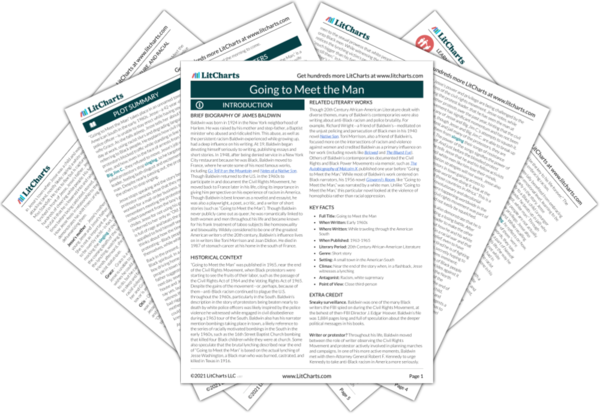Welcome to the LitCharts study guide on James Baldwin's Going to Meet the Man. Created by the original team behind SparkNotes, LitCharts are the world's best literature guides.
Going to Meet the Man: Introduction
Going to Meet the Man: Plot Summary
Going to Meet the Man: Detailed Summary & Analysis
Going to Meet the Man: Themes
Going to Meet the Man: Quotes
Going to Meet the Man: Characters
Going to Meet the Man: Symbols
Going to Meet the Man: Theme Wheel
Brief Biography of James Baldwin

Historical Context of Going to Meet the Man
Other Books Related to Going to Meet the Man
- Full Title: Going to Meet the Man
- When Written: Early 1960s
- Where Written: While traveling through the American South
- When Published: 1963-1965
- Literary Period: 20th Century African-American Literature
- Genre: Short story
- Setting: A small town in the American South
- Climax: Near the end of the story when, in a flashback, Jesse witnesses a lynching
- Antagonist: Racism, white supremacy
- Point of View: Close third-person
Extra Credit for Going to Meet the Man
Sneaky surveillance. Baldwin was one of the many Black writers the FBI spied on during the Civil Rights Movement, at the behest of then-FBI Director J. Edgar Hoover. Baldwin’s file was 1,884 pages long and full of speculation about the deeper political messages in his books.
Writer or protestor? Throughout his life, Baldwin moved between the role of writer observing the Civil Rights Movement and protestor actively involved in planning marches and campaigns. In one of his more active moments, Baldwin met with then-Attorney General Robert F. Kennedy to urge Kennedy to take anti-Black racism in America more seriously.







